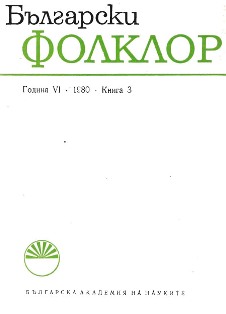Чудесните дървета в българските вълшебни приказки (Опит за систематизация и изясняване на семантиката)
The Wonderful Trees in Bulgarian Fairy Tales (An Attempt at Systematizing and Elucidating Semantics)
Author(s): Lyubomira ParpulovaSubject(s): Anthropology
Published by: Институт за етнология и фолклористика с Етнографски музей при БАН
Summary/Abstract: The purpose of this article is to show the wonderful trees as they exist in Bulgarian fairy tales. The first part is a classification. The following groups are differentiated, the numbers of types from the index of Aarne-Thompson also being indicated, in which they are traditionally found: I. A. A tree which bears golden apples; B. A tree with an eagle’s nest at the top; II. A. A tree from the fruit of which a girl emerges; B. A tree, grown up from a fish bone, which turns into a maiden; III. A. A tree which has grown out of a snake’s bone, which has treasures in its crown; B. A tree which has gold buried at its roots and is therefore barren; IV. A. A singing tree; B. A tree which has grown out of a man’s corpse; V. A tree, the hero’s brother, which has grown out of a fish; VI. A tree, the acquisition of which leads to a change of sex; VII. A tree which causes metamorphoses in a human’s body; VIII. The Silver Apple-tree in the Bad Fairly’s garden; IX. Various trees. In the second part the meanings of the wonderful trees are examined in connection with the stories themselves. It is found that the varieties I. A., II. A., B., IV. B., V. and VI. are connected with ideas about life, death and wedding, seen as biological phenomena. Varieties III. A., B. and VII. are connected with man’s social life. I. A. appears in connection with ideas on the construction of the world, while IV. A. and VIII. represent the unusual trees, growing in the world of supernatural beings. The brief characterization of the symbolism of trees in mythical and religious ideas shows parallels with „ the Tree of Life”, „ the Cosmic Tree” and „ the Tree of Knowledge”. The conclusion is that they are only the „subtext” of the wonderful trees. In themselves they do not suggest an impression of symbolical images. The mythical semantics is preserved and expressed not so images, as in the plot as a whole.
Journal: Български фолклор
- Issue Year: VI/1980
- Issue No: 3
- Page Range: 12-24
- Page Count: 13
- Language: Bulgarian
- Content File-PDF

